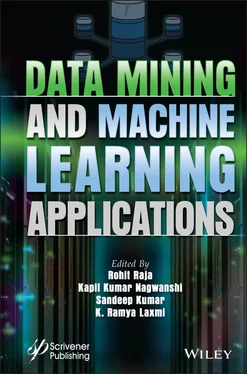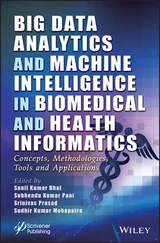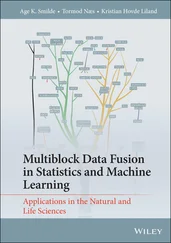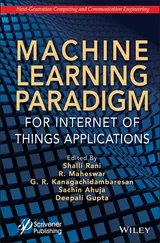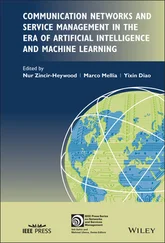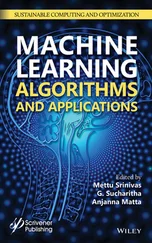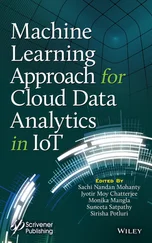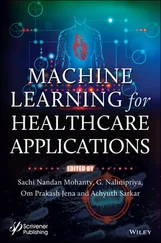Data Mining and Machine Learning Applications
Здесь есть возможность читать онлайн «Data Mining and Machine Learning Applications» — ознакомительный отрывок электронной книги совершенно бесплатно, а после прочтения отрывка купить полную версию. В некоторых случаях можно слушать аудио, скачать через торрент в формате fb2 и присутствует краткое содержание. Жанр: unrecognised, на английском языке. Описание произведения, (предисловие) а так же отзывы посетителей доступны на портале библиотеки ЛибКат.
- Название:Data Mining and Machine Learning Applications
- Автор:
- Жанр:
- Год:неизвестен
- ISBN:нет данных
- Рейтинг книги:3 / 5. Голосов: 1
-
Избранное:Добавить в избранное
- Отзывы:
-
Ваша оценка:
- 60
- 1
- 2
- 3
- 4
- 5
Data Mining and Machine Learning Applications: краткое содержание, описание и аннотация
Предлагаем к чтению аннотацию, описание, краткое содержание или предисловие (зависит от того, что написал сам автор книги «Data Mining and Machine Learning Applications»). Если вы не нашли необходимую информацию о книге — напишите в комментариях, мы постараемся отыскать её.
The book elaborates in detail on the current needs of data mining and machine learning and promotes mutual understanding among research in different disciplines, thus facilitating research development and collaboration.
Audience
Data Mining and Machine Learning Applications — читать онлайн ознакомительный отрывок
Ниже представлен текст книги, разбитый по страницам. Система сохранения места последней прочитанной страницы, позволяет с удобством читать онлайн бесплатно книгу «Data Mining and Machine Learning Applications», без необходимости каждый раз заново искать на чём Вы остановились. Поставьте закладку, и сможете в любой момент перейти на страницу, на которой закончили чтение.
Интервал:
Закладка:
It could be seen that the less instructive highlights for this inhabitant were sifted through with zero coefficients, while the remaining shows the indoor CO 2focus and dampness are the most significant inspirational drivers for this tenant to change the ventilation stream rate. By this methodology, the primary driver for inhabitant No. 1 to alter ventilation flowrate is distinguished.
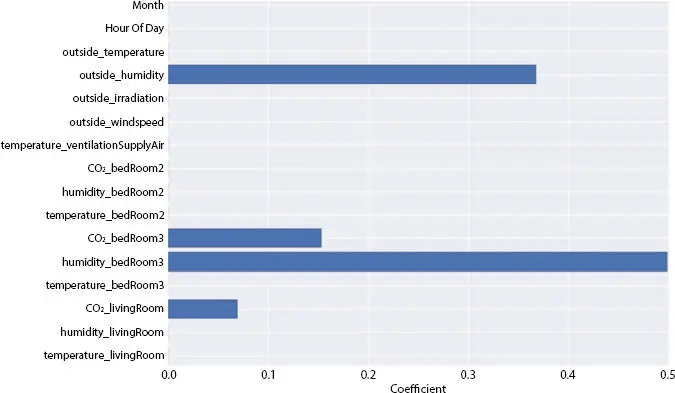
Figure 2.11 Highlight significance yield.
2.5 Discussion
Learning identical models for each tenant could reveal the individual level’s fundamental motivating led components. Nevertheless, it may be common for different individuals to have different inclinations and not to carry on likewise. Subsequently, expanded to a network level, a bunching investigation might gather inhabitants into a few designs of trigger behavior. The most educational list of capabilities, with its coefficients, is omitted from the yield of the measured relapse model. All the key-driven elements fall into two classifications: time-related components including month, non-weekend day/weekend, hour-day data, and condition-related variables including indoor temperature, relative humidity, CO 2emphasis, and outside climate information. According to these two measures and with essential resizing, Figure 2.12may address the tenants involved in the study. The flat hub speaks to the significance of indoor condition factors in determining the actions of tenants, while the vertical hub speaks to the significance of time-related factors.
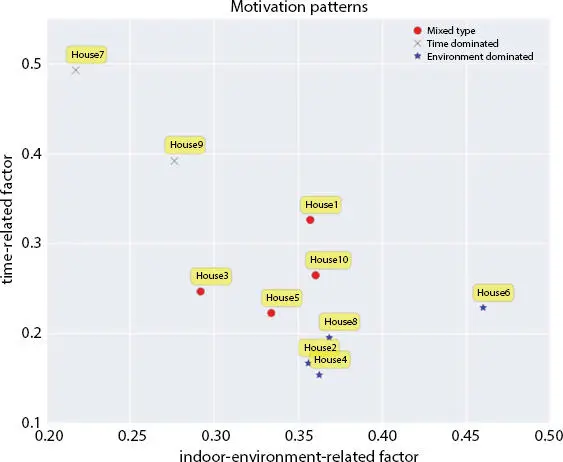
Figure 2.12 Cause patterns of ventilation system operations.
K-Means calculation shows three distinct kinds of tenants:
– Indoor condition touchy inhabitants (plotted in star): 2, 4, 6, 8
– Time delicate tenants (plotted in the cross): 7, 9
– Mixed sort inhabitants (plotted in specks): 1, 3, 5, 10.
The unpredictability of inhabitants’ conduct cause example could be seen from the information mining results. The Indoor condition touchy tenants are bound to cooperate with their ventilation control board when they feel somewhat unsatisfied about the indoor solace, while the time-delicate inhabitants are bound to carry on with fixed schedules (e.g., when they wake up or return from work and so forth, they modify the ventilation). There are likewise a few people in the middle of, as blended kind tenants, their practices are affected impressively by the two elements in a similar time.
2.6 Conclusion
In this chapter, we considered the expected properties of Data mining like Mining dynamic/streaming information, Mining diagram, and system information, Mining heterogeneous/multi-source information, Mining high dimensional information, Mining imbalanced information, Mining sight and sound Information, Mining logical information Mining consecutive information, Mining interpersonal organizations Mining spatial and fleeting Information and an information mining technique is proposed to examine the inhabitant conduct of modifying the ventilation stream in an as of late revamped network in the Netherlands. The goal is to uncover the shrouded inspiration driving tenants’ conduct and look for conceivable personal conduct standards among various individuals. An L1-regularized calculated relapse classifier was created and tuned to foresee the inhabitant’s conceivable response to a specific situation, during which it additionally assesses the overall significance of each element in the dynamic cycle numerically.
In a wider context, the comparison between tenants showed three impressive inspiring examples. To be particular the earth-driven sort, contrasting the tenants who are more touchy to the ecological variables, the time-driven sort corresponds to the occupants who have relatively set temporal tendencies, just like the occupants of the merged kind, whose behavior is far more unpredictable with no single tendency design that is clear on the situation and transient aspects.
The information-based strategy to explore tenants’ conduct presented in this investigation empowers additional opportunity to use the BMS information. The taking in drawn from the investigation could be utilized either to display individuals’ conduct all the more unequivocally in the structure reproduction program just as to add to the improvement of the insightful structure. Additionally, other than the customary ways to deal with exploring individuals’ conduct by directing a study or meeting, the algorithmic technique is more strong with less man-made aggravations.
References
1. Babcock, B., Babu, S., Datar, M., Motwani, R., Widom, J., Models and issues in data stream systems, in: Proceedings of PODS , 2002.
2. Golab, L. and Ozsu, M.T., Issues in Data Stream Management. SIGMOD Rec ., 32, 2, 5–14, June 2003.
3. Henzinger, M., Raghavan, P., Rajagopalan, S., Computing on data streams. Technical Note 1998-011, Digital Systems Research Center, Palo Alto, CA, May 1998.
4. Muthukrishnan, S., Data streams: Algorithms and applications. Proceedings of the Fourteenth Annual ACM-SIAM Symposium on Discrete Algorithms , 2003.
5. Muthukrishnan, S., Seminar on Processing Massive Data Sets , Available Online: http://athos.rutgers.edu/%7Emuthu/stream-seminar.html, 2003.
6. Garofalakis, M., Gehrke, J., Rastogi, R., Querying and mining data streams: You only get one look a tutorial. SIGMOD Conference 2002 , p. 635, 2002.
7. Kargupta, H., CAREER: Ubiquitous Distributed Knowledge Discovery from Heterogeneous Data. NSF Information and Data Management (IDM) Workshop , 2001.
8. Muthukrishnan, S., Data streams: Algorithms and applications. Proceedings of the Fourteenth Annual ACM-SIAM Symposium on Discrete Algorithms , 2003.
9. Pinto, H., Han, J., Pei, J., Wang, K., Chen, Q., Dayal, U., Multidimensional sequential pattern mining, in: Proceedings of the Tenth International Conference on Information and Knowledge Management , ACM, pp. 81–88, 2001.
10. Mabroukeh, N.R. and Ezeife, C.I., A taxonomy of sequential pattern mining algorithms. ACM Comput. Surv. (CSUR) , 43, 1, 3, 2010.
11. Garofalakis, M.N., Rastogi, R., Shim, K., Spirit: Sequential pattern mining with regular expression constraints, in: VLDB , vol. 99, pp. 7–10, 1999.
12. Agrawal, R. and Srikant, R., Mining sequential patterns, in: Data Engineering, 1995. Proceedings of the Eleventh International Conference , IEEE, pp. 3–14, 1995.
13. Echo, E., Raïssi, C., Ienco, D., Jay, N., Napoli, A., Poncelet, P., Quantin, C., Teisseire, M., Healthcare trajectory mining by combining multidimensional components and itemsets, in: International Workshop on New Frontiers in Mining Complex Patterns , Springer, pp. 109–123, 2012.
14. Yu, C.-C. and Chen, Y.-L., Mining sequential patterns from multidimensional sequence data. IEEE Trans. Knowl. Data Eng ., 17, 1, 136–140, 2005.
15. Raïssi, C. and Plantevit, M., Mining multidimensional sequential patterns over data streams, in: International Conference on Data Warehousing and Knowledge Discovery , Springer, pp. 263–272, 2008.
16. Padhy, N. and Panigrahi, R., Multi relational data mining approaches A data mining technique. International Journal of Computer Applications (0975 – 8887) Volume 57– No.17, pp. 23-32, November 2012, arXiv preprint arXiv:1211.3871, 2012.
Читать дальшеИнтервал:
Закладка:
Похожие книги на «Data Mining and Machine Learning Applications»
Представляем Вашему вниманию похожие книги на «Data Mining and Machine Learning Applications» списком для выбора. Мы отобрали схожую по названию и смыслу литературу в надежде предоставить читателям больше вариантов отыскать новые, интересные, ещё непрочитанные произведения.
Обсуждение, отзывы о книге «Data Mining and Machine Learning Applications» и просто собственные мнения читателей. Оставьте ваши комментарии, напишите, что Вы думаете о произведении, его смысле или главных героях. Укажите что конкретно понравилось, а что нет, и почему Вы так считаете.
